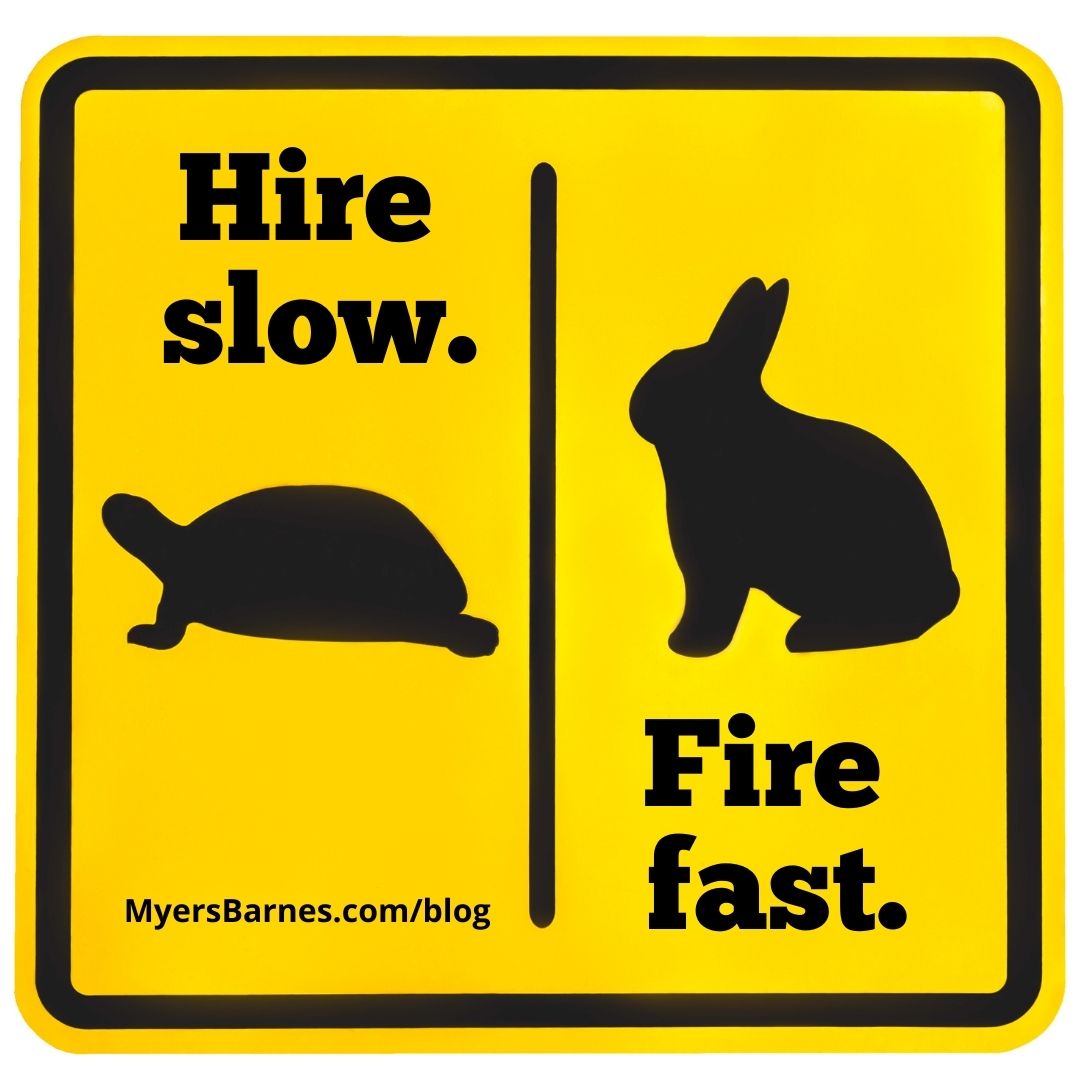 The recruiting process is filled with promise. It’s exciting to see the possibilities for your growing team. But remember that you’re preparing to commit to someone who can become either a powerful asset or the cause of your sleepless nights. Follow these tips to hire slow and fire fast to avoid the path to deep regret.
The recruiting process is filled with promise. It’s exciting to see the possibilities for your growing team. But remember that you’re preparing to commit to someone who can become either a powerful asset or the cause of your sleepless nights. Follow these tips to hire slow and fire fast to avoid the path to deep regret.
The hiring process has all the reality of a first date. Both parties are on their best behavior. The applicant has presented a résumé that makes them look as enticing as possible. They’re dressed to impress, whatever they think will impress you. After all the usual questions, you decide whether another get-together is desirable. Not everyone deserves a second chance. For those who do, take your time until they’ve impressed you to take the next step.
Why should you hire slow and fire fast?
Steve Jobs and Guy Kawasaki spoke about the impact of the Bozo Explosion. If you hire “A” players, they’ll want to populate the company by hiring other “A” players. They want to be with innovative, bright, and forward-thinking colleagues. They don’t want to be the smartest person in the room because that limits their growth.
But the same doesn’t hold true for lesser types. They feel threatened by people who challenge them by offering new ideas. So, a “B” player hires a “C” player. The “C” player who remains in the company will seek out “D” players to populate their team. Thus, the Bozo Explosion.
You can prevent this outbreak of mediocrity by working through the hiring process with intent.
How to hire slow
Hiring slow doesn’t mean taking your old sweet time to schedule interviews and make decisions. Approach the hiring process with purpose.
Start with a detailed job description. Avoid simply relying on the existing one. Use it as a starting point and then build in everything you’ve learned about the experience, qualities, skills, and knowledge that contributes to succeeding in this role.
Be clear about the long-term view of the job. Is there potential to move up? Does the company have expansion plans in the foreseeable future? Maybe the right person will grow into a leadership role. Don’t limit your search for what you need now. Look ahead into what they COULD become. What does an “A” player look like in your organization?
While you’re building the job description, make a separate list of qualities that are desirable in applicants. What should you look for? How about confidence, curiosity, and good body language? Did they turn off their phone during the interview? That simple step is a sign of respect and indicates the individual is totally focused on the interview.
Consider the team dynamic. When referring to past successes, does the candidate use “I” or “we”? If you’re looking for a team player, you need someone who willingly acknowledges the help of others. Will this candidate be a roll-up-your-sleeves-and-pitch-in person? A person who resists a task on the basis of “it’s not in my job description” is the perfect example of why you should fire quickly!
Ask your own team about the qualities they’d like in their co-worker. They might have a very different list than yours!
Brake for mistakes
Let’s go back to the dating analogy. You’ve committed to someone by hiring them. It doesn’t take long before the honeymoon is over and you see the real person, not the facade that was presented to you.
Start every employment agreement with a probationary period. Unless something out-of-the-ordinary has occurred that changes your business—like a pandemic, maybe—90 days should be enough time to determine who is going to last. If you’re still not convinced after 90 days, ask yourself and the employee why it’s not working. There could be an easy fix. Or the fix might be a quick firing. The sooner you address the problem, the sooner you can both move on to a better situation.
Here’s a quick tip for figuring out whether someone is a keeper. If you have to ask if you’re in love, you’ve already answered the question. In the same way, if you find yourself wondering whether or not someone is the right fit with your company and team, the answer is “no”. You get those niggling thoughts because your subconscious is sending you a warning signal.
An underperformer can be taught to become an achiever, if you want to invest the time. But it’s not a guaranteed result. For example, you can’t teach attitude. How long do you want to hang on to find out? How much is it costing you to wait?
Overcome the guilt of firing
Guilt can be a major reason that employers fail to fire fast. Here are two ways to manage guilt when firing someone:
- Accept that they de-hired themself. If you provided accurate feedback about their performance and they failed to make the necessary improvements, the employee made the choice not to do the job. You’re not firing this person, but merely finalizing their decision not to perform as directed.
- Offer a quitting bonus. Your guilt stems from concern over eliminating the employee’s income. First of all, please refer to #1. If that’s not enough, do what Amazon does (which they inherited from Zappo’s when Amazon acquired the shoe retailer). The “Pay to Quit” program offers Amazon’s warehouse workers between $1,000 and $5,000 to willingly leave their job. Amazon doesn’t want to employ people who don’t want to be there. This incentive gives them the choice and a pocket full of cash—a one-time choice that also comes with never returning to Amazon’s employment. Unlike severance pay which goes with terminating an employee, the worker saves face by making it appear they’ve chosen to leave of their own accord.
Leadership requires the ability to make tough choices and engage in difficult conversations. Instead of looking at the immediate impact of firing an employee, think about how the decision benefits both sides in the long run. You’re freeing up someone to find a position that better suits their skill set. An unhappy worker can also be toxic to the rest of your team. Meanwhile, your organization isn’t weighed down by someone who isn’t contributing as you need them to be. Knowing when to let go is essential for anyone.
When you’re sifting through the candidates, don’t settle for less just because someone is better than the others. You’re not looking for “better”. Seek out the “best”. That might take longer than you wanted. Never allow the need for f illing the role to pressure you into hiring someone just to fill the seat.
If you need help recruiting and training “A-level” new home sales professionals, talk to me.


